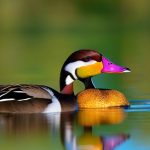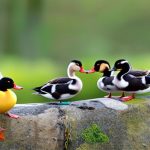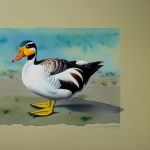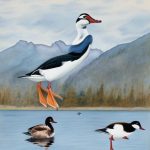The Australian Wood Duck, also known as Maned Duck, is a species of dabbling duck found throughout Australia and New Zealand. These ducks are easily recognizable by their striking appearance, with a combination of dark brown and white plumage, and a distinctive dark mane on the back of their neck. They are medium-sized ducks, with a length of around 45-50 centimeters and a wingspan of 75-85 centimeters. Australian Wood Ducks are commonly found in a variety of habitats, including wetlands, marshes, rivers, and lakes, where they feed on a diet of grasses, seeds, and aquatic plants.
Australian Wood Ducks are known for their strong pair bonds and are often seen in monogamous pairs. They are also highly social birds and can often be found in large flocks, especially during the non-breeding season. These ducks are also known for their distinctive call, which is a loud, high-pitched whistle that can be heard from a distance. Overall, Australian Wood Ducks are an important and iconic species in the Australian avian ecosystem, playing a crucial role in maintaining the balance of their habitats.
Key Takeaways
- Australian Wood Ducks are a common species of waterfowl found throughout Australia.
- Breeding behavior of Australian Wood Ducks involves forming monogamous pairs and breeding in the spring and summer months.
- Nesting habits of Australian Wood Ducks include choosing tree hollows or nest boxes near water for laying eggs.
- Mating rituals of Australian Wood Ducks involve courtship displays and vocalizations to attract a mate.
- Incubation and hatching of Australian Wood Duck eggs takes around 28-30 days, with the female responsible for incubation.
Breeding Behavior of Australian Wood Ducks
Breeding season for Australian Wood Ducks typically occurs during the spring and summer months, when the weather is warmer and food sources are more abundant. During this time, male wood ducks engage in elaborate courtship displays to attract a mate. These displays often involve the males flapping their wings, bobbing their heads, and emitting soft calls to signal their readiness to breed. Once a pair bond is formed, the male and female will engage in mutual preening and other bonding behaviors to strengthen their relationship.
After the pair bond is established, the female wood duck will begin to search for a suitable nesting site. Nesting sites are typically located near water sources, such as ponds or rivers, where the female can easily access food for herself and her future offspring. Once a suitable site is found, the female will construct a nest using grasses, reeds, and other plant materials, creating a shallow depression lined with down feathers for insulation. The male will often stand guard nearby to protect the female and the nesting site from potential predators.
Nesting Habits of Australian Wood Ducks
Australian Wood Ducks are known for their unique nesting habits, which often involve using natural cavities or abandoned tree hollows as nesting sites. However, they are also known to adapt to human-altered landscapes and will readily use nest boxes or artificial structures provided for them. The female wood duck will lay a clutch of around 8-12 eggs, which she will then incubate for approximately 30 days. During this time, the male will continue to stand guard and protect the nesting site from potential threats.
The nesting habits of Australian Wood Ducks are crucial to their reproductive success, as they provide a safe and secure environment for the eggs to develop. The female will diligently tend to the eggs, turning them regularly to ensure even heat distribution and humidity levels. Once the eggs hatch, the female will assist the ducklings in leaving the nest and guide them to water sources where they can begin to forage for food. Overall, the nesting habits of Australian Wood Ducks play a vital role in ensuring the survival of their offspring and maintaining healthy population levels.
Mating Rituals of Australian Wood Ducks
Mating rituals among Australian Wood Ducks are characterized by elaborate courtship displays and vocalizations designed to attract a mate. Male wood ducks will often engage in displays of strength and agility to impress females, such as vigorous wing flapping and head bobbing. These displays are accompanied by soft calls and whistles that signal the male’s readiness to breed. Once a pair bond is formed, the male and female will engage in mutual preening and other bonding behaviors to strengthen their relationship.
During the mating ritual, the male wood duck will also engage in protective behaviors to ensure the safety of the female and the nesting site. This may involve standing guard near the female while she constructs the nest or actively defending the area from potential predators. The mating rituals of Australian Wood Ducks are essential for establishing strong pair bonds and ensuring successful reproduction. These rituals also play a crucial role in maintaining social cohesion within wood duck populations and contribute to the overall health of their ecosystems.
Incubation and Hatching of Australian Wood Duck Eggs
After the female wood duck has laid her clutch of eggs, she will begin the incubation process, which typically lasts for around 30 days. During this time, the female will diligently tend to the eggs, turning them regularly to ensure even heat distribution and humidity levels. The male will continue to stand guard nearby, protecting the nesting site from potential threats such as predators or other competing ducks.
As the incubation period progresses, the eggs will begin to show signs of hatching, with small cracks appearing on the surface as the ducklings inside start to break free. The female will assist the ducklings in leaving the nest by gently nudging them out of their shells and guiding them towards water sources where they can begin to forage for food. The hatching process is a critical time for Australian Wood Ducks, as it marks the beginning of their offspring’s journey towards independence and survival in their natural habitat.
Parental Care and Rearing of Australian Wood Duck Chicks
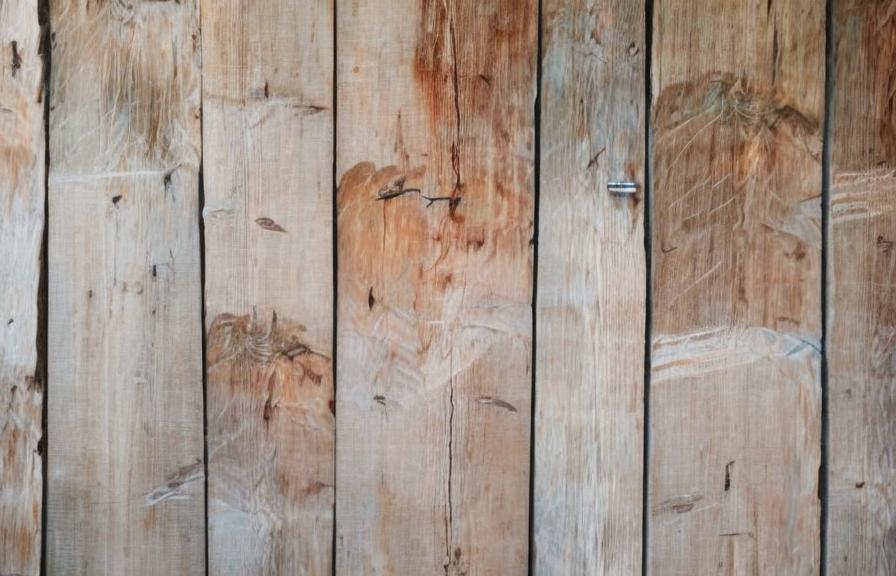
Once the ducklings have hatched, both the male and female wood ducks play an active role in caring for their offspring. The female will lead the ducklings to water sources where they can begin to forage for food, while the male will continue to stand guard and protect them from potential threats. Australian Wood Duck chicks are precocial, meaning they are born with their eyes open and are able to walk and feed themselves shortly after hatching.
The parental care provided by Australian Wood Ducks is crucial for the survival of their offspring, as it helps them navigate their new environment and learn essential skills for foraging and avoiding predators. The parents will continue to watch over their ducklings as they grow and develop, gradually allowing them more independence as they become more self-sufficient. Overall, parental care and rearing behaviors among Australian Wood Ducks play a vital role in ensuring the survival of their offspring and maintaining healthy population levels within their ecosystems.
Conservation Efforts for Australian Wood Ducks
Conservation efforts for Australian Wood Ducks are crucial for ensuring the long-term survival of this iconic species. Habitat loss and degradation pose significant threats to wood duck populations, as wetlands and other natural habitats continue to be impacted by human development and climate change. Efforts to protect and restore these habitats are essential for providing suitable breeding grounds and food sources for wood ducks.
In addition to habitat conservation, measures such as predator control and nest box installation have been implemented to support wood duck populations. These efforts help reduce predation on nesting sites and provide alternative nesting opportunities for wood ducks in areas where natural cavities may be limited. Public education and outreach programs also play a crucial role in raising awareness about the importance of conserving Australian Wood Ducks and their habitats.
Overall, conservation efforts for Australian Wood Ducks are essential for preserving this iconic species for future generations to enjoy. By addressing threats such as habitat loss, predation, and human disturbance, we can help ensure that wood duck populations remain healthy and sustainable in their natural habitats.
If you’re interested in learning more about breeding waterfowl, you might want to check out this informative article on how to care for goslings. It provides valuable insights into the care and breeding of geese, which can be helpful for those looking to expand their knowledge beyond Australian wood duck breeding.
FAQs
What is the breeding season for Australian wood ducks?
The breeding season for Australian wood ducks typically occurs from August to December.
Where do Australian wood ducks build their nests?
Australian wood ducks build their nests in tree hollows, often near water, or in artificial nesting boxes.
How many eggs do Australian wood ducks typically lay?
Australian wood ducks typically lay a clutch of 9-11 eggs.
How long does it take for Australian wood duck eggs to hatch?
It takes approximately 28-30 days for Australian wood duck eggs to hatch.
Do Australian wood ducks mate for life?
Australian wood ducks are known to form long-term pair bonds, but they do not necessarily mate for life.
What is the role of the male Australian wood duck in breeding?
The male Australian wood duck plays a role in protecting the nesting site and the female during the breeding season.
How long do Australian wood duck chicks stay with their parents after hatching?
Australian wood duck chicks typically stay with their parents for several months after hatching, learning essential survival skills before becoming independent.
Meet Walter, the feathered-friend fanatic of Florida! Nestled in the sunshine state, Walter struts through life with his feathered companions, clucking his way to happiness. With a coop that’s fancier than a five-star hotel, he’s the Don Juan of the chicken world. When he’s not teaching his hens to do the cha-cha, you’ll find him in a heated debate with his prized rooster, Sir Clucks-a-Lot. Walter’s poultry passion is no yolk; he’s the sunny-side-up guy you never knew you needed in your flock of friends!


